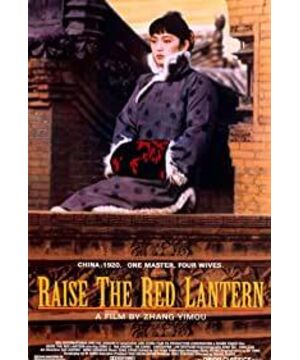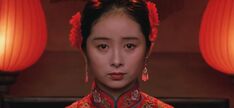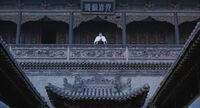The movie "Raise the Red Lantern" is based on the novella "Wives and Concubines". "Wives and Concubines" came out in 1989. It is Su Tong's famous work. The core idea of the novel is the life scene and the corresponding survival principle of the feudal family that is generated by "polygamy". The novel highlights that the protagonist Songlian is an educated woman. After her father died, she was forced to become the fourth concubine of a wealthy family. Since then, her life has changed a lot. From the moment she entered the compound , she entered a terrifying and intriguing living environment. In order to fight for a place, Songlian's personality was amazingly reflected in this living environment, and her life was full of helplessness and obedience.
When it comes to "High Red Lanterns", we have to mention the lanterns that appear repeatedly in the film. As an object that is always interspersed in the film, it always plays the role of threading the needle. Under the premise of the feudal society, the lantern plays a symbol and strong irony. Bright red is a distinctive symbol of the Chinese nation. Whether it is on the national flag or the world-renowned Tang suit, red is an indispensable main color. Zhang Yimou used a lot of bright red to express the theme. Hanging lamps and sealing lamps, the bright red and the black form a sharp contrast, and the theme is more prominent under the contrast.
The film still adopts a simple shooting method, using a large number of long shots in the film, which is vividly displayed from the beginning. After a few minutes of confession, the camera gave Song Lian a close-up, reflecting the dim window, looking so lonely and helpless. She walked to the Chen family compound alone, deliberately missed the big sedan chair, and insisted on taking the package by herself after entering the house, which showed her stubbornness. The film also uses a camera to show Songlian's perseverance and persistence along the way.
After entering the compound, there is a language conflict with the girl Yan'er, which lays the foundation for the contradictions behind the film.
The complex character relationships in the film are the most thought-provoking, and of course the dramatic conflict in the film is also the success of the film. From the first dispute between the fourth concubine and the girl Yaner, to the battle with the seemingly tough third wife, and finally the inside story of the incident was transformed into the conflict with the second wife, which reached a climax.
There are two long takes in the film that are still fresh in my memory. One set is the shot of extinguishing the lantern. The first is a close-up of the lantern. The old man uses a long pipe to aim at the lantern, blows a long breath, and the lantern goes out; then, the old man turns around and gives a close-up view; then, there is another extinguished lantern; then the camera gives a close-up of the lantern , turned from bright to off; then zoomed out, giving the flat a panoramic view. Less than ten shots in a row, the lights out are depicted, while the feudal customs are presented just right. The other group is the process of Song Lian looking for the flute. First, there is a close-up view of Song Lian turning over the box and calling the maid. Immediately after the wild goose comes into the painting, Song Lian’s questioning to her and the girl’s answer are two close-ups. The cross-examination approached the subject, and the girl answered the same; the fire of anger ignited between the two again, and after several scene changes, Song Lian abruptly got up and went out; the two entangled and rushed out of the screen; In the room, the long-lens shooting began: the surprise of seeing the broken lanterns in the room, and Song Lian looking for the flute but unexpectedly found the cursed puppet. The camera specially gave the puppet a close-up, with the words impressively written on it. With the word Song Lian, the tense atmosphere immediately spread. During the fight between the two, they also used panning, deliberately fiddling with the camera to create exciting scenes. These two sets of shots are the essence of the whole film.
The film uses most of the dramatic music as the background music to set off the film's plot, and secondly, to set off the mysterious atmosphere of the Chen family. There will be some harmony music interspersed in the play, which will open up the perspective, which is especially sad. There is always a voice-over in the film. As an indispensable part of the film's plot, the master has always only heard the voice and did not see the person. Perhaps as the culprit of this tragedy, he has no face to face; perhaps it is a deliberate arrangement by the director, who wants to use him to set off the darkness of feudal ethics.
In the film, there is a second wife with a bodhisattva face and a scorpion heart. In the face of the injustice of fate, she is still struggling to the death, using all her means; there is a third wife who does not succumb to the feudal bondage, and Chen Fu, who has a strict family education, still maintains an ambiguous relationship with Dr. Gao. There are also Yan'er, who admits her fate, but tries her best to change the status quo; and Songlian, a college student who has received a higher education. It can be seen that the feudal etiquette has destroyed people so deeply. Zhang Yimou used such a simple lens language to tell us this shocking story, and at the same time criticized the decay and decline of the old society.
A film that is deeply rooted in people's hearts, the original most simple expression is even more shocking.
View more about Raise the Red Lantern reviews











